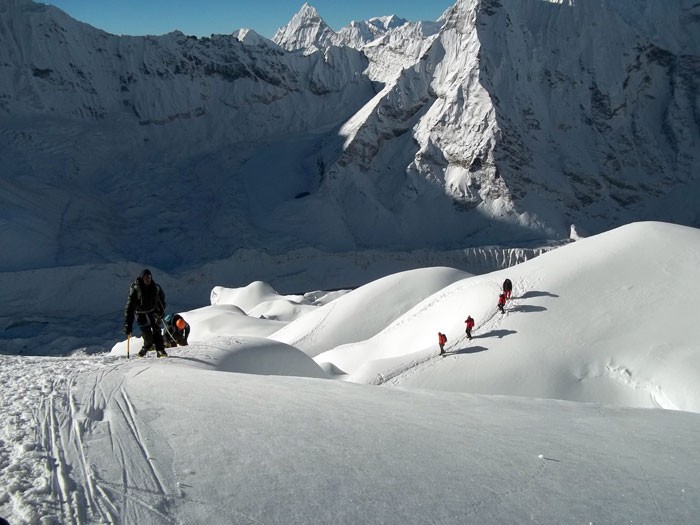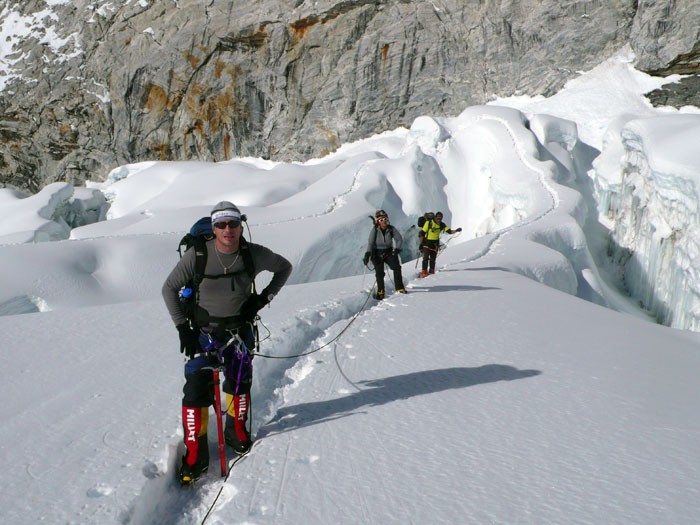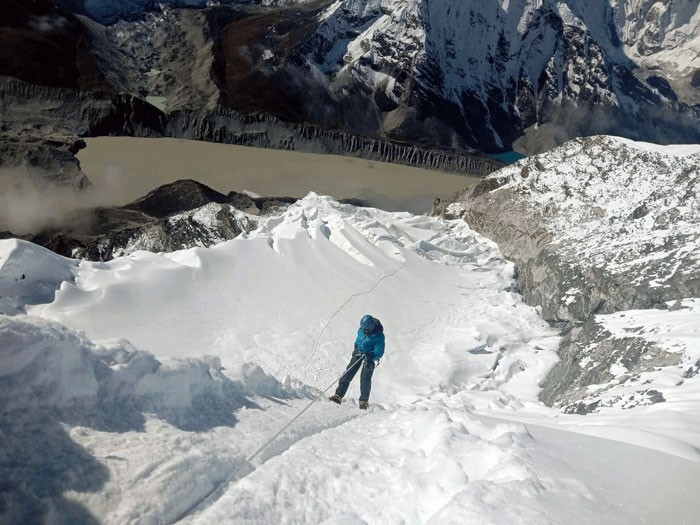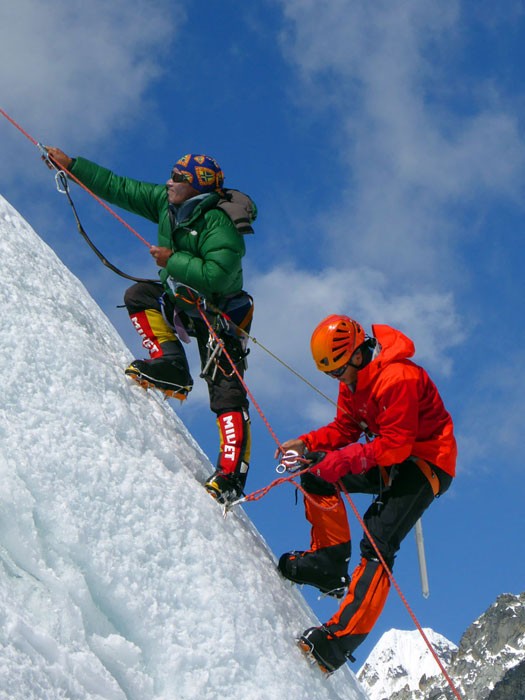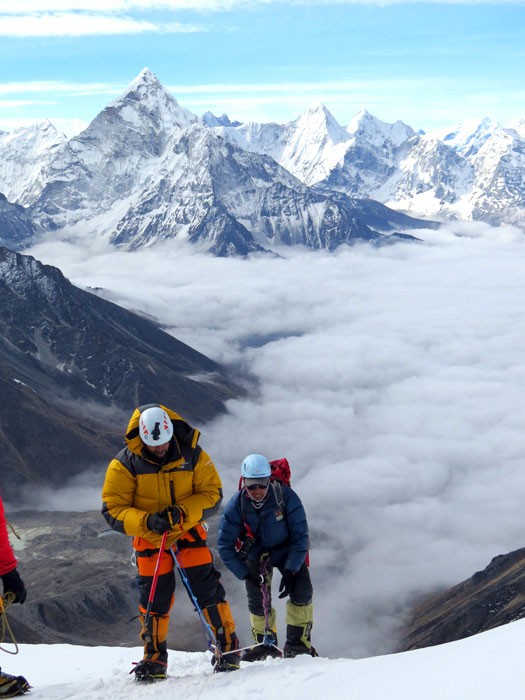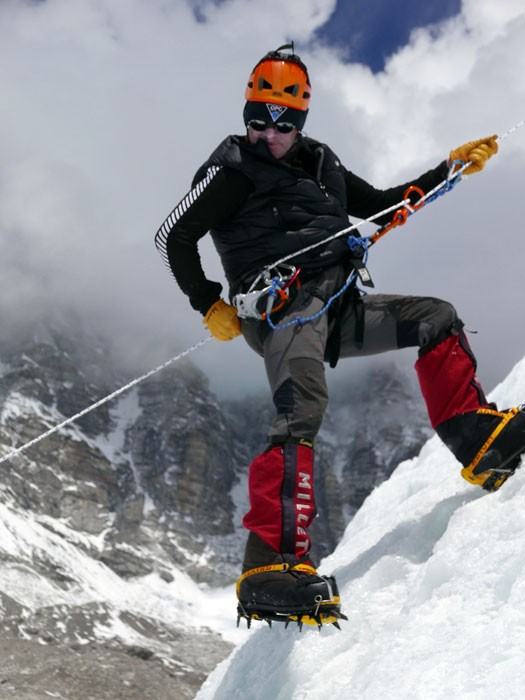Everest February Quick Preparatory Climb
Climb Island Peak and Lobuche Peak during just 20 days in February. Perfect preparation for Everest in April !!
Everest February Quick Preparatory Climb Cost
Our full-service expedition includes:
- British, European, or American leader
- Expert climbing Sherpa
- Transport to base camp to/from Kathmandu, including accommodation
- Transport of all equipment to and from basecamp
- Skillful base camp cooks
- Three meals each day
- Group emergency equipment and satellite phone
- Private tents in basecamp (no sharing)
- Full base camp with dinning tent, showers, bathroom, and solar charger
- Double occupancy tents above base camp
- All permit fees and liaison officers
- Use of group gear and supplies
- Two nights stay in a Kathmandu hotel on arrival and two nights prior to departure in a double room. Private rooms are available for a small additional fee.
- Airport transfer
What is not included?
- International flights to/from Kathmandu
- Mountain climbing rescue and travel insurance
- Personal climbing equipment and clothing
- Gratuities for staff
- Nepalese visa
Everest February Quick Prep Climb Itinerary
- Day 1 – Arrive Kathmandu
- Day 2 – Preparation and gear checking
- Day 3 – Fly to Lukla and sleep Phakding
- Day 4 – Namche
- Day 5 – Rest Namche
- Day 6 – Pangboche
- Day 7 – Dingboche
- Day 8 – Dingboche Rest
- Day 9 – Chukung
- Day 10 – Island Peak BaseCamp
- Day 11 – Island Peak Summit and back to Chungung
- Day 12 – Thukla
- Day 13 – Lobuche High Camp
- Day 14 – Summit Lobuche and back to Thukla
- Day 15 – Funki Thanka
- Day 16 – Jorsalle
- Day 17 – Lukla
- Day 18 – Fly back to Kathmandu
- Day 19 – Rest day at Kathmandu
- Day 20 – Fly Back home.
Everest February Quick Preparatory Climb Experience and Training
Extensive experience is not required for climbing Everest February Quick Preparatory Climb. The most important thing is for members to be in adequate walking fitness. You may attempt this climb as a novice and we will teach you what you need to know.
Prior to joining our group, please see your doctor and obtain the necessary permission and advice, as well as medications for travel in extremes of altitude, and also for exotic locales.
Everest February Quick Preparatory Climb Equipment
Climbing:
- Climbing harness
- 5 meters (16 ft.) of 6mm accessory cord
- Figure 8 abseil/belay device (tube style devices, i.e. ATC will not work on fixed lines)
- Full size ascender (i.e. PetzlAscention)
- 2 locking carabiners, 1 large and 1 small
- 4 non-locking carabiners
- Ice axe with leash
- Steel crampons with anti-balling plates
- Trekking poles
- Abseiling/Rappelling Gloves
Upper Body:
- 2 cotton t-shirts
- 2 synthetic t-shirts
- 2 long sleeve synthetic shirts
- Light-weight soft shell jacket
- Medium weight insulatingjacket (fleece, down, or synthetic)
- Hard shell jacket with hood, waterproof and breathable (Gore-Tex or similar)
- Heavy down coat
- For 6,000m peaks a very warm down coat with hood or an 8,000m coat with hood
- For 7,000m peaks an 8,000m coat with hood
- For 8,000m peaks an 8,000m down coat with hood or an 8,000m suit can be used instead
Hands:
- Lightweight poly-liner gloves
- Mid-weight soft shell gloves – water/wind resistant
- Heavy- weight waterproof gloves – Gore-tex shell with removable liner
- Expedition weight mittens -Gore-tex over mitt matched polar fleece mitt liner
Head:
- Helmet
- Warm hat that covers your ears
- Balaclava
- Face mask
- Baseball hat or brimmed sun hat
- Glacier sunglasses with side shields
- Ski goggles with light and dark lenses
- Glasses with clear lenses to protect your eyes while climbing to the summit on windy nights. (cost less than 10 dollars in Kathmandu)
- Headlamp with extra batteries and bulbs
- Buff/neck gaiter
- Bandana or head scarf (optional)
Lower Body:
- Synthetic underwear
- Hiking shorts
- Hiking pants
- 2 pair lightweight thermal bottoms
- Medium or expedition weight thermal bottoms
- Polar fleece or soft shell pants
- Waterproof/breathable pants with full side zips (Gore-Tex or similar)
- Heavy insulating pants
- For 6,000m peaks: Down or synthetic pants will full zips
- For 7,000m peaks: 8,000m down pants
- For 8,000m peaks: 8,000m down pants or a 8,000m suit can be used instead
Feet:
- Boots
- For 6,000m peaks: Plastic or composite double boots (Koflach, La SportivaSpantik, etc) Modern waterproof, single boots designed for 4-5,000m peaks may be suitable if they can be worn with 2 pairs of socks and vapor barrier lines and/or they are equipped with overboots
- For 7,000m: Plastic or composite double boots (Koflach, La SportivaSpantik, etc)
- For 8,000m peaks: 8,000m boots - One-Sport Millet Everest boots or equivalent
- Sturdy leather walking boots
- Trainers, running shoes and/or sandals
- Down booties (optional)
- 3 pair med-heavy poly or wool socks
- 2 pair poly or wool liner socks (optional)
- Vapor barrier liner socks (optional)
- 2 pair lightweight trekking socks
- Cotton socks for in town
Sleeping:
- Down sleeping bag
- For 6,000m peaks: -18C or 0F
- For 7,000m peaks:-23C or -10F (If you sleep cold consider -29C or -20F)
- For 8,000m peaks: -29C or -20F (If you sleep cold consider -40C or -40F)
- An additional down sleeping bag for basecamp for the following climbs: Everest, Lhotse, AmaDablam, Manaslu, Cho Oyu, Shishapangma, Broad Peak, K2, Gasherbrum I and II, Spantik, K2/Broad Peak Everest training climb. For Mastagata a second sleeping bag is optional, but highly recommended.
- Down base camp sleeping bag should be rated to -10C or 15F (If you sleep cold consider -18C or 0F)
- Down base camp sleeping bag should be rated to -10C or 15F (If you sleep cold consider -18C or 0F)
- 2 closed cell foam kari-mats (sleeping pads) for use in basecamp and high altitude (these can be purchased inexpensively in Kathmandu)
- High quality inflatable sleeping pad designed for cold weather (Thermarest)
- Patch kit for inflatable pad
Rucksack and Travel Bags:
- Medium rucksack/backpack (50-70 litres / 3000-4500 cubic inches, can be used as carry-on bag)
- Waterproof rucksack cover (optional)
- 2 large (120+ L / 7500+ cubic inch) duffle kit bags for clothing and equipment
- Small luggage locks for duffel kit bags
Personal Hygiene:
- Female or male hygiene supplies
- 2 tubes lip sun cream
- Large tube skin sun cream (min factor 30)
- Anti-mosquito cream
- Toothpaste/brush
- Hand sanitizer gel (small-medium bottle)
- Bar of soap small towel
- Hand wipes
- Face Mask
- Hand sanitiser
- Disposable gloves
- Disinfectant wipes
Medical:
- Small personal first-aid kit. (Simple and Light) Aspirin, first-aid tape, plasters (band-aids), personal medications, etc.
- Blister repair kit
- 10 anti-diarrhea pills
- 20 anti-headache pills
- 10 cough and/or cold medicine
- Anti-altitude sickness pills: Diamox, Acetylzolamide
- 10 Stomach antibiotics: Ciprofloxacin, etc.
- 5 Azithromycin tables
- Steri pen or bottle of water purification tablets
- Cough sweets/lozenges (Halls/Stepils)
- Earplugs
- Extra prescription glasses/contact lenses and supplies
Personal Food:
- Snack food/daily energy food
- Everest training Nepal/Tibet, AmaDablam, Baruntse: 2-4kg (4.5-9lbs)
- Spantik, Cho Oyu, Shishapangma, Mustagata, Manasu: 2-5kg (4.5-11lbs)
- Broad Peak, K2, Gasherbrum I/II, K2/Everest training, Everest, Lhotse: 3-6kg (6.5-13lbs)
- Dehydrated meals (freeze-dried dinners) for summit attempt
- Everest training Nepal/Tibet, AmaDablam: 2 meals
- Spantik, Cho Oyu, Shishapangma, Mustagata, Manasu, Baruntse: 3 meals
- Broad Peak, K2, Gasherbrum I/II, K2/Everest training, Everest, Lhotse: 5 meals
- Small roll of repair tape
- Sewing repair kit
- Cigarette lighter
- Small box matches
- Compass or GPS
- Battery powered alarm clock/watch
- Camera with extra cards and extra batteries
- Nylon stuff sacks for food and gear storage
- 2 water bottles (1 litre) wide-mouth Nalgene
- Pee bottle (1litre or larger)
- Plastic cup and spoon
- Small folding knife
- Binoculars (optional)
- 4 very large, waterproof, heavy duty disposable rubbish sacks size 150-200 litre = 40-50 gallon. These are necessary for packing. thanks
- Passport, 2 extra passport photos, flight ticket, flight itinerary
- Separate photocopies of passport and relevant visa pages, proof of insurance
- Dollars, pounds, or euros cash
- Bank/ATM/Cash and credit cards
- Bathing suit/swim suit (you never know)
- Paperback books, playing cards, ipod/mp3 player, musical instruments, extra batteries, etc.
- Travel clothes for basecamp and in town
- Umbrella (optional)
- Small solar panels for personal electronics (optional)
Group Equipment:
We provide group gear, equipment, and supplies including: rope, ice, rock, and snow anchor protection, tents; stoves, fuel, walkie-talkie radios, bamboo marker wands, etcetera. A personal tent will be provided for each member at base camp. On the upper mountain, team members will share tents. In base camp, a shower, toilet, solar charger, and a dining tent will be provided
Everest February Quick Prep Climb Photo Gallery
Everest February Quick Preparatory Climb Application
Please fill out an application and return it to us with your refundable ten-percent deposit to hold your place on the team.
Everest February Quick Prep Climb Application for World Team Members (UK Office) : PDF Form or MS Word Doc
Everest February Quick Prep Climb Application for US Team Members (US Office) : PDF Form or MS Word Doc
In addition to your application, we will need the following at least two months before the Island Peak trip begins:
- Completed Payment
- Oxygen order (if any)
- Sherpa order (if any)
- Trip Registration form
- 1 Passport sized photo
- A scan of your passport identification pages
- Complete flight itinerary
- Proof of travel, accident, and repatriation insurance. We strongly recommend Global Rescue, with at least $50,000 worth of helicopter rescue insurance.
- Trip cancellation/interruption insurance is recommended
Please contact us with any questions you may have.


